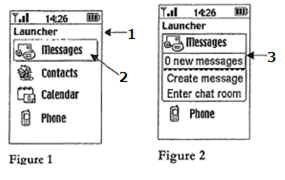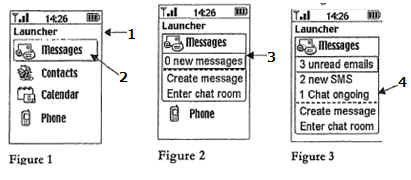
|
CAFC判決 Core Wireless Licensing v. LG Elecs.,
Inc. 2018年 01月
25日 101条の保護適格性が認められた判決。 OPINION
by JUDGE Wallach Summarized
by Tatsuo YABE – 2018-02-12 |
|
2018年1月10日のFINJAN判決に続く、101条に関する判決でFINJANと同様にCoreの特許クレームは非常に広範な権利範囲を規定している。問題となったCOREの特許(USP8,713,476)は、携帯電話のような小さいスクリーン上でユーザーが所望するApplicationへのアクセスを容易にするインターフェースに関する発明をクレームしており、出願時のままで拒絶理由を受けることなく権利化された。従来技術(及び現在の携帯電話においても)においてユーザーが所望するApplicationに到達するのに小さい画面のアイコンを何度もクリックする操作が要求される。例)メイルを送信しようと思ってもメイルのアイコンをクリックし、メイル作成のボックス「新規作成」をクリックするなどの操作が必要となる。Core特許476の経過書類を確認するも許可可能理由はクレーム1の文言がコピペ―ストされているのみである。
|
筆者が明細書を読む限りではクレーム1の後段のWherein句に「wherein the application summary is displayed while the one or more applications are in an un-launched state /Application 2を起動することなくApplicationサマリー3を表示する」とあり、この特徴に対応する明細書の開示は、該当するApplicationの上にハイライト表示され、1.2秒後にApplicationサマリー(図2の3)が表示されると記載されている。即ち、以下の図においてハイライト状態のMessage 2(どれがハイライト状態になるかはユーザーの使用頻度によっても変わる)をクリックすることなくApplicationサマリー3が自動的に表示されるという特徴が要のように理解される。
|
|
|
しかし昨今の審査においてはこのようなクレームは抽象概念を対象とする(claim
is directed to an abstract idea)ものと判断され101条拒絶を受ける可能性が高いのではないだろうか? Alice最高裁判決が2014年6月19日でPre-Aliceで審査された(Core476特許は2013年10月に出願され2014年4月29日に特許されている)とは言うもののPost-Aliceの訴訟でAlice2パートテストに基づき審理されている。
|
但し、少なくとも本判決は出願実務者にとって101条拒絶に反論するために有益な判決である。特に本判決文の中に101条Friendly判決群(Enfish判決、Thales判決、Visual
Memory判決、Fijnjan判決)の要約を列記しており、以下のように述べている。
|
本判決(Core
Wireless)では、Enfish判決、Thales判決、Visual
Memory判決、Fijnjan判決において改善されたシステムがクレームされているのと同様にCoreの476特許クレームは従来のシステムを改善する特定のシステム(※)を規定していると述べている。
|
特に、本判決文の7〜9ページの内容は101条拒絶に反論するのに有益であるのでReproduceしているので適時参照されたい(以下Reference参照)|
(※)⇒ 「従来システムを改善する特定のシステム」というキーワードを言い換えると、結局は以下のフレーズに集約されるのではないか(筆者は101条拒絶に反論する上でCAFC判決で唯一整合性がある文言は以下と理解している)。
「クレームされた発明はa
technical problem(従来技術の問題)に対しa
technical solution(技術的な解決手段)を提供する、或いは、a
tangible and useful resultを現出する構成要素がクレームされている」
|
(以上筆者)
■■■■■■■■■■■■■■■■■■■■■■■■■■■■■■■■■■
|
特許権者:Core Wireless
Licensing
被疑侵害者:LG Elecs.
Inc.,
特許:USP 8,713,476
特許発明の概要:
携帯電話のような小さいスクリーン上でユーザーが所望するApplicationへのアクセスを容易にするインターフェースに関する発明。
|
争点:
複数の争点があるが101条に関しては、「476特許のクレーム1はAlice/Mayo判決に基づき101条の特許保護適格性を満たすか?」である。
|
代表的な476特許のクレーム:
1. A computing device comprising a display screen, the computing
device being configured to display on the screen a
menu listing one or more applications, and additionally being
configured to display on the screen an
application summary that can be reached directly from the menu,
wherein the application summary displays a limited list of data offered
within the one or more applications, each of the data in the list being
selectable to launch the respective application and enable the selected data to
be seen within the respective application, and wherein the
application summary is displayed while the one or more
applications are in an un-launched state.
クレーム1の後段のWherein句に「Applicationを起動することなくApplicationサマリー3,4を表示する」とあるが、この意味合いは明細書によると、該当するApplicationの上にハイライト表示され、1.2秒後にApplicationサマリー(図2の3、或いは、図3の4)が表示されると記載されている。
|
|
1-screen display; 2-list of applications; 3-App Snapshot (summary
window);
|
■ 101条適格性が認められた理由(Alice第1ステップをクリア:Abstractアイデアではない)
CAFCはAlice判決後の自身の101条関連判決(101条を満たすと判断した判決:Enfish;
Thales; Visual Memory; Finjan)を引用し、Core特許のクレームはコンピューター装置のユーザーインターフェースを改善することに対する(directed
to)という理由でAliceステップ1をクリアすると判断した。
|
より詳細には、476特許クレーム1ではApplicationサマリーがメニュから直接アクセスできること;Applicationサマリーが限定されたデータセットをリスト表示すること、リスト表示されたデーターを選択することで対応するApplicationが起動すること、選択されたデーターが当該Applicationの領域内で目視できること;さらに、Applicationを起動することなくApplicationサマリーが表示されることが規定されている。これら特徴は、ユーザーに対し限定された情報を具体的な様式で表示することを規定しているのであって、従来例のように一般的な索引(Index)を伴う表示によるユーザーインターフェースの手法とは異なる。
|
Enfish、Thales、Visual
Memory、Fijnjan判決において改善されたシステムがクレームされており、これら判決と同様に476特許クレームは従来のシステムを改善する特定のシステムを規定していると述べている。
|
************************************
Reference
|
Core Wireless v. LG Elects.: Fed.
Cir. 2017-01-25)
7〜9ページの内容は101条拒絶に反論するのに有益と考えます。
|
At step one, we must “articulate what the claims are directed to with enough
specificity to ensure the step one inquiry is meaningful.” Thales Visionix
Inc. v. United States, 850 F.3d 1343, 1347 (Fed. Cir. 2017). Although there
is “difficulty inherent in delineating the contours of an abstract idea,” Visual
Memory, 867 F.3d at 1259, we must be mindful that “all inventions at some
level embody, use, reflect, rest upon, or apply laws of nature, natural
phenomena, or abstract ideas.” Mayo, 566 U.S. at 71. We also ask
whether the claims are directed to a specific improvement in the capabilities of
computing devices, or, instead, “a process that qualifies as an ‘abstract
idea’ for which computers are invoked merely as a tool.” Enfish, LLC v.
Microsoft Corp., 822 F.3d 1327, 1336 (Fed. Cir. 2016).
We previously have held claims focused on various improvements of systems
directed to patent eligible subject matter under § 101. For example, in Enfish,
we held claims reciting a self-referential table for a computer database
eligible under step one because the claims were directed to a particular
improvement in the computer’s functionality. 822 F.3d at 1336. That the
invention ran on a general-purpose computer did not doom the claims because
unlike claims that merely “add[] conventional computer components to
well-known business practices,” the claimed self-referential table was “a
specific type of data structure designed to improve the way a computer stores
and retrieves data in memory.” Id. at 1338–39. In Thales,
we held claims reciting an improved method of utilizing inertial sensors to
determine position and orientation of an object on a moving platform not
directed to an abstract idea or law of nature. 850 F.3d at 1349. We noted
that even though the system used conventional sensors and a mathematical
equation, the claims specified a particular configuration of the sensors and
a particular method of utilizing the raw data that eliminated many of the
complications inherent in conventional methods. Id. at 1348–49.
In Visual Memory, we held claims
directed to an improved computer memory system with programmable operational
characteristics defined by the processor directed to patent-eligible subject
matter. 867 F.3d at 1259. The claimed invention provided flexibility that prior
art processors did not possess, and obviated the need to design a separate
memory system for each type of processor. Id. And
most recently, in Finjan, Inc.
v. Blue Coat Systems, Inc., we held claims directed to a behavior-based
virus scanning method directed to patent eligible subject matter because they
“employ[] a new kind of file that enables a computer security system to do
things it could not do before,” including “accumulat[ing] and utiliz[ing]
newly available, behavior-based information about potential threats.” 2018 WL
341882 (Fed. Cir. Jan. 10, 2018). The claimed behavior-based scans, in contrast
to prior art systems which searched for matching code, enabled more “nuanced
virus filtering” in analyzing whether “a downloadable’s code . . .
performs potentially dangerous or unwanted operations.” Id. at
6–7. We held the claims “therefore directed to a non-abstract
improvement in functionality, rather than the abstract idea of computer security
writ large.” Id. at 8.
The asserted claims in this case are directed to an improved user
interface for computing devices, not to the abstract idea of an index, as
argued by LG on appeal.
Although
the generic idea of summarizing information certainly existed prior to the
invention, these claims are directed to a particular manner of summarizing and
presenting information in electronic devices. Claim 1 of the ’476 patent
requires “an application summary that can be reached directly from the
menu,” specifying a particular manner by which the summary window must be
accessed. The claim further requires the application summary window list a
limited set of data, “each of the data in the list being selectable to launch
the respective application and enable the selected data to be seen within the
respective application.” This claim limitation re-strains the type of data
that can be displayed in the summary window. Finally, the claim recites that the
summary window “is displayed while the one or more applications are in an
un-launched state,” a requirement that the device applications exist in a
particular state. These limitations disclose a specific manner of displaying
a limited set of information to the user, rather than using conventional user
interface methods to display a generic index on a computer. Like the
improved systems claimed in Enfish,
Thales, Visual Memory, and Finjan,
these claims recite a specific improvement over prior systems,
resulting in an improved user interface for electronic devices.